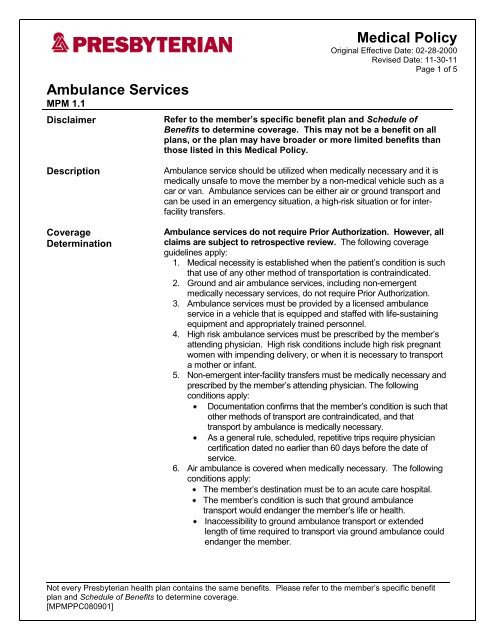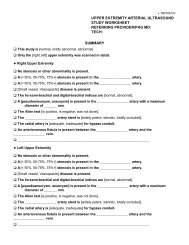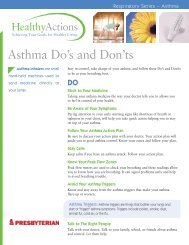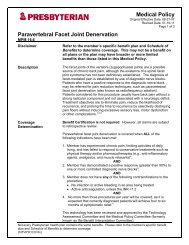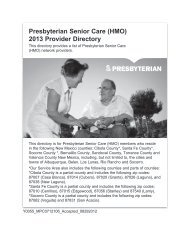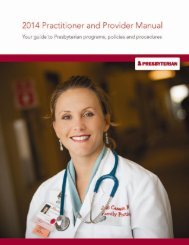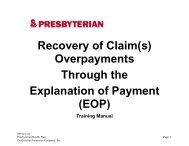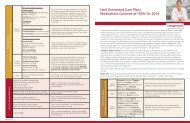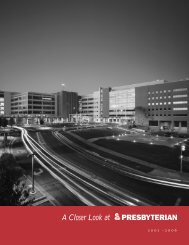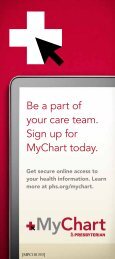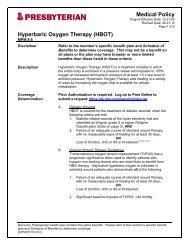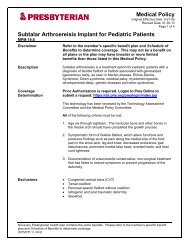Title of Medical Policy - Presbyterian Healthcare Services
Title of Medical Policy - Presbyterian Healthcare Services
Title of Medical Policy - Presbyterian Healthcare Services
Create successful ePaper yourself
Turn your PDF publications into a flip-book with our unique Google optimized e-Paper software.
Ambulance <strong>Services</strong><br />
MPM 1.1<br />
Disclaimer<br />
<strong>Medical</strong> <strong>Policy</strong><br />
Original Effective Date: 02-28-2000<br />
Revised Date: 11-30-11<br />
Page 1 <strong>of</strong> 5<br />
Refer to the member’s specific benefit plan and Schedule <strong>of</strong><br />
Benefits to determine coverage. This may not be a benefit on all<br />
plans, or the plan may have broader or more limited benefits than<br />
those listed in this <strong>Medical</strong> <strong>Policy</strong>.<br />
Description<br />
Coverage<br />
Determination<br />
Ambulance service should be utilized when medically necessary and it is<br />
medically unsafe to move the member by a non-medical vehicle such as a<br />
car or van. Ambulance services can be either air or ground transport and<br />
can be used in an emergency situation, a high-risk situation or for interfacility<br />
transfers.<br />
Ambulance services do not require Prior Authorization. However, all<br />
claims are subject to retrospective review. The following coverage<br />
guidelines apply:<br />
1. <strong>Medical</strong> necessity is established when the patient’s condition is such<br />
that use <strong>of</strong> any other method <strong>of</strong> transportation is contraindicated.<br />
2. Ground and air ambulance services, including non-emergent<br />
medically necessary services, do not require Prior Authorization.<br />
3. Ambulance services must be provided by a licensed ambulance<br />
service in a vehicle that is equipped and staffed with life-sustaining<br />
equipment and appropriately trained personnel.<br />
4. High risk ambulance services must be prescribed by the member’s<br />
attending physician. High risk conditions include high risk pregnant<br />
women with impending delivery, or when it is necessary to transport<br />
a mother or infant.<br />
5. Non-emergent inter-facility transfers must be medically necessary and<br />
prescribed by the member’s attending physician. The following<br />
conditions apply:<br />
Documentation confirms that the member’s condition is such that<br />
other methods <strong>of</strong> transport are contraindicated, and that<br />
transport by ambulance is medically necessary.<br />
As a general rule, scheduled, repetitive trips require physician<br />
certification dated no earlier than 60 days before the date <strong>of</strong><br />
service.<br />
6. Air ambulance is covered when medically necessary. The following<br />
conditions apply:<br />
The member’s destination must be to an acute care hospital.<br />
The member’s condition is such that ground ambulance<br />
transport would endanger the member’s life or health.<br />
Inaccessibility to ground ambulance transport or extended<br />
length <strong>of</strong> time required to transport via ground ambulance could<br />
endanger the member.<br />
Not every <strong>Presbyterian</strong> health plan contains the same benefits. Please refer to the member’s specific benefit<br />
plan and Schedule <strong>of</strong> Benefits to determine coverage.<br />
[MPMPPC080901]
Ambulance <strong>Services</strong><br />
MPM 1.1<br />
<strong>Medical</strong> <strong>Policy</strong><br />
Original Effective Date: 02-28-2000<br />
Revised Date: 11-30-11<br />
Page 2 <strong>of</strong> 5<br />
Weather or traffic conditions exist which make ground<br />
ambulance impractical, impossible or overly time consuming.<br />
If a member dies before an air ambulance arrives, the air<br />
ambulance is covered for the initial leg <strong>of</strong> trip, IF the air<br />
ambulance began its trip before the member died. Payment will<br />
be made according to the appropriate fee schedule or provider<br />
contract.<br />
7. Origin and destination information – all requirements noted above<br />
apply:<br />
Ambulance services are covered from any point <strong>of</strong> origin to the<br />
nearest hospital or skilled-nursing facility (SNF) that is capable<br />
<strong>of</strong> furnishing the required level and type <strong>of</strong> care for the<br />
member’s illness or injury.<br />
Ambulance services are covered from a hospital or SNF to the<br />
member’s home.<br />
Ambulance services are covered from a SNF to the nearest<br />
supplier <strong>of</strong> medically necessary services not available at the<br />
SNF where the member is a resident, including the return trip.<br />
Non-emergency ambulance transportation is not covered if the<br />
service could have been safely and effectively provided at the<br />
point <strong>of</strong> origin (residence, SNF, hospital, etc.). Such<br />
transportation is not covered even if the patient could only have<br />
gone for the service by ambulance.<br />
Ambulance services are covered for dialysis treatment for<br />
ESRD patients from the member’s home to the nearest facility<br />
that furnishes renal dialysis, including the return trip, when all <strong>of</strong><br />
the above requirements are met.<br />
Documentation<br />
Requirements<br />
It is the responsibility <strong>of</strong> the ambulance supplier to maintain, and furnish<br />
if requested, complete and accurate documentation <strong>of</strong> the beneficiary’s<br />
condition to demonstrate the ambulance service is medically necessary<br />
and meets criteria. The following documentation may be required:<br />
Physician certification <strong>of</strong> medical necessity. For repetitive<br />
services, this certification should be dated no earlier than 60<br />
days before the date <strong>of</strong> the service. Please note: See<br />
Trailblazer’s LCD L28627 for circumstances when providers<br />
other than a physician may provide a certificate <strong>of</strong> medical<br />
necessity for non-repetitive non-emergent transports.<br />
Detailed description <strong>of</strong> the patient’s condition at the time <strong>of</strong><br />
transport, which must be consistent with other supporting<br />
medical documentation. This description should report<br />
symptoms, functional status, any traumatic event, existing<br />
safety issues, any special precautions taken, and any special<br />
monitoring undertaken.<br />
Point <strong>of</strong> pickup, number <strong>of</strong> miles, dispatch record.<br />
Not every <strong>Presbyterian</strong> health plan contains the same benefits. Please refer to the member’s specific benefit<br />
plan and Schedule <strong>of</strong> Benefits to determine coverage.<br />
[MPMPPC080901]
Ambulance <strong>Services</strong><br />
MPM 1.1<br />
<strong>Medical</strong> <strong>Policy</strong><br />
Original Effective Date: 02-28-2000<br />
Revised Date: 11-30-11<br />
Page 3 <strong>of</strong> 5<br />
For hospital-to-hospital transport, indicate specific treatment<br />
or specialist.<br />
Bed confinement is not a sole criterion in determining<br />
medical necessity <strong>of</strong> ambulance transportation. It is one<br />
factor that is considered in medical necessity determinations.<br />
To be considered as bed-confined, the following criteria must<br />
be met:<br />
o Inability to get up from the bed without assistance.<br />
o Inability to ambulate.<br />
o Inability to sit in a chair or a wheelchair.<br />
Exclusions<br />
Definitions<br />
Ambulances services are not covered in the following circumstances:<br />
1. Any ambulance service that is not medically necessary.<br />
2. Ambulance services used as a convenience for either the member<br />
or family.<br />
3. Ambulance service when the member refuses assessment,<br />
treatment or transportation.<br />
4. Air ambulance when the time required to transport the member by<br />
ground ambulance poses no threat and the point <strong>of</strong> pick-up is<br />
accessible by a land vehicle.<br />
5. Ambulance service (ground or air) if the member is pronounced<br />
dead prior to the time the ambulance is called.<br />
6. Non-emergency wheelchair transport (a specially-designed<br />
vehicle equipped with a wheelchair lift or other modifications to<br />
transport a patient in a wheelchair).<br />
<strong>Medical</strong> Necessity for Ambulance Transfer: The member’s condition is<br />
such that other means <strong>of</strong> transportation are contraindicated.<br />
Ambulance Service: A licensed transportation service, capable <strong>of</strong><br />
providing medically necessary life support care in the event <strong>of</strong> a lifethreatening<br />
emergency.<br />
Emergency Ambulance <strong>Services</strong>: Ambulance services provided after<br />
the sudden onset <strong>of</strong> what reasonably appears to be a medical condition<br />
that manifests itself by symptoms <strong>of</strong> sufficient severity, including severe<br />
pain, that the absence <strong>of</strong> immediate medical attention could reasonably<br />
be expected by a reasonable layperson, to result in:<br />
Jeopardy to the person’s health<br />
Serious impairment <strong>of</strong> bodily functions<br />
Serious dysfunction <strong>of</strong> any bodily organ or part<br />
Disfigurement to the person<br />
High-risk Ambulance: Ambulance services that are non-emergent but<br />
medically necessary for a high-risk patient and ordered by a physician.<br />
This does not include mental health conditions and/or circumstances.<br />
Not every <strong>Presbyterian</strong> health plan contains the same benefits. Please refer to the member’s specific benefit<br />
plan and Schedule <strong>of</strong> Benefits to determine coverage.<br />
[MPMPPC080901]
Ambulance <strong>Services</strong><br />
MPM 1.1<br />
<strong>Medical</strong> <strong>Policy</strong><br />
Original Effective Date: 02-28-2000<br />
Revised Date: 11-30-11<br />
Page 4 <strong>of</strong> 5<br />
Inter-facility Transfer: Ground or air ambulance transportation between<br />
any <strong>of</strong> the following: hospitals, skilled nursing facilities or diagnostic<br />
facilities.<br />
Coding<br />
The coding listed in this <strong>Medical</strong> <strong>Policy</strong> is for reference only.<br />
Covered and non-covered codes are included within this list.<br />
HCPCS©<br />
Codes<br />
A0425<br />
Ground mileage, per statute mile<br />
Description<br />
A0426 Ambulance service, ALS, non-emergency transport, level 1<br />
A0427 Ambulance service, ALS, emergency transport, level 1<br />
A0428<br />
A0429<br />
A0433<br />
A0434<br />
A0435<br />
A0436<br />
A0888<br />
Ambulance service, BLS, non-emergency transport<br />
Ambulance service, BLS, emergency transport<br />
Advanced life support, level 2 (ALS2)<br />
Specialty Care Transport (SCT)<br />
Fixed wing air mileage, per statute mile<br />
Rotary wing air mileage, per statute mile<br />
Non-covered ambulance mileage, per mile (e.g., for miles traveled beyond appropriate<br />
facility)<br />
References<br />
1. Centers for Medicare and Medicaid <strong>Services</strong>, Medicare Benefits<br />
<strong>Policy</strong> Manual (Pub. 100-02), Chapter 10 – Ambulance <strong>Services</strong>.<br />
Accessed on the Internet 08-27-09: Accessed on the internet 11-4-11<br />
http://www.cms.hhs.gov/manuals/Downloads/bp102c10.pdf<br />
2. New Mexico Administrative Code (NMAC): <strong>Title</strong> 13, Chapter 10, Part<br />
13.9D. “Basic Health Care <strong>Services</strong>: Emergency and urgent care<br />
services.” Accessed on the Internet 08-27-09: Accessed on the Internet<br />
11-4-11 http://www.nmcpr.state.nm.us/nmac/cgibin/hse/homepagesearchengine.exeurl=http://www.nmcpr.state.nm.us/<br />
nmac/parts/title13/13.010.0013.htm;geturl;terms=13.10<br />
3. New Mexico Administrative Code (NMAC): <strong>Title</strong> 8, Chapter 306, Part<br />
7.11D. “<strong>Services</strong> Included in the SCI Benefit Package: Emergency and<br />
urgently needed health services.” Accessed on the Internet 06-25-09:<br />
http://www.nmcpr.state.nm.us/nmac/cgibin/hse/homepagesearchengine.exeurl=http://www.nmcpr.state.nm.us/<br />
nmac/parts/title08/08.306.0007.htm;geturl;terms=8.306<br />
Not every <strong>Presbyterian</strong> health plan contains the same benefits. Please refer to the member’s specific benefit<br />
plan and Schedule <strong>of</strong> Benefits to determine coverage.<br />
[MPMPPC080901]
Ambulance <strong>Services</strong><br />
MPM 1.1<br />
<strong>Medical</strong> <strong>Policy</strong><br />
Original Effective Date: 02-28-2000<br />
Revised Date: 11-30-11<br />
Page 5 <strong>of</strong> 5<br />
4. Center for Medicare and Medicaid <strong>Services</strong>, TrailBlazer Health<br />
Enterprises. Local Coverage Determination for Ambulance <strong>Services</strong><br />
(L28627). Original Determination Effective Date: 04-14-09.<br />
5. <strong>Presbyterian</strong> Health Plan, Benefit Interpretation Manuals for<br />
Commercial, Medicare Advantage and SCI<br />
Approval<br />
Signatures:<br />
Clinical Quality Committee:<br />
Mark Whitaker MD<br />
<strong>Medical</strong> Director:<br />
Albert Rizzoli MD<br />
Date: November 30, 2011<br />
Publishing<br />
History:<br />
02-28-00: Original effective date for Commercial Benefit Interpretation<br />
Manual, Revised 7-25-05.<br />
01-22-01: Original effective date for Medicare Advantage Benefit<br />
Interpretation Manual, Revised 07-22-02, 11-25-02, 06-23-<br />
03, 06-28-04, 04-23-07.<br />
06-27-06: Original effective date for State Coverage Insurance Benefit<br />
Interpretation Manual.<br />
12-07-07: Merging <strong>of</strong> Benefit Interpretation Manuals as noted above<br />
into <strong>Medical</strong> <strong>Policy</strong>.<br />
08-26-09: Annual update and revision.<br />
11-30-11: Annual Review<br />
This <strong>Medical</strong> <strong>Policy</strong> is intended to represent clinical guidelines describing medical appropriateness and is<br />
developed to assist <strong>Presbyterian</strong> Health Plan and <strong>Presbyterian</strong> Insurance Company, Inc. (<strong>Presbyterian</strong>) Health<br />
<strong>Services</strong> staff and <strong>Presbyterian</strong> medical directors in determination <strong>of</strong> coverage. The <strong>Medical</strong> Policies are not a<br />
treatment guide and should not be used as such.<br />
For those instances where a member does not meet the criteria described in these guidelines, additional<br />
information supporting medical necessity is welcome and may be utilized by the medical directors in reviewing the<br />
case. Please note that all PHP <strong>Medical</strong> Policies are available online at:<br />
http://www.phs.org/phs/healthplans/providers/healthservices/<strong>Medical</strong>/index.htm<br />
Not every <strong>Presbyterian</strong> health plan contains the same benefits. Please refer to the member’s specific benefit<br />
plan and Schedule <strong>of</strong> Benefits to determine coverage.<br />
[MPMPPC080901]


